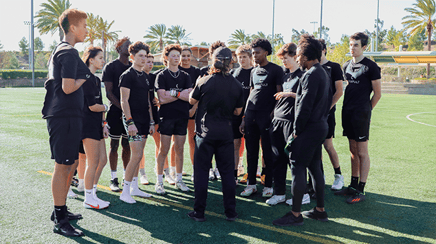Improving Acceleration
A huge reason we help athletes improve their speed is so that they can apply it to a game.
Just about every athlete we train wants to get faster, yes, but their ultimate goal is to be able to apply the improvement in order to see more success in their sport.
I've been watching the Women's World Cup quite a bit and it got us thinking about the work we did with the Men’s team last year.
Everything we did with the USMNT was meant to help improve on field performance.
We’ve talked about it before, but the applications are so important for any coach that’s serious about training speed effectively.

Importance of Speed in Soccer (and most sports)
Summing up the work with the Men’s National Team in one word would be: acceleration.
We’ve talked about it a ton. On the Les Spellman Podcast, on other podcasts, but it’s so key.
How do you get to velocity?
Take two athletes, one that can run 22 MPH but it takes them 6 seconds to get there.
One that can get only get to 21 MPH but they get there in 3 seconds,
In a sport like soccer, the argument could be made that the athletes that to get to that top speed sooner are going to be more impactful.
Now, you could make the argument the other way based on position. But the point is how impactful acceleration is.
Influencing how athletes accelerate can help athletes access a higher percentage of max speed sooner. So in soccer this means they will be able to get to the ball faster, beat a defender, etc.
It massively dictates the game if you improve an athlete's acceleration.
Here are some facts about soccer that our team finds interesting:
- There’s 60-70 accelerations in a soccer game. That’s 60-70 opportunities to close space, get to a ball, and so on.
- There may only be 3-5 runs in a game where an athlete reaches maximal speed. Talking 90-95% velocity.
If an athlete can’t accelerate well, or they use too much energy to accelerate, if they can’t accelerate efficiently it will probably cause people to think they aren’t in shape, or they aren’t fit.
Acceleration is the key.
How to Improve Acceleration
The obvious next question.
Practically speaking, how is acceleration improved?
From a high level: Load Velocity and Force Velocity Profiles.
Force Velocity Profiles
These will give us an idea of how the athlete accelerates, and in which zones. Are they good early? Late? Which area is the athlete weak in?
Taking this information, we know how we can help them improve.
- Poor early? Heavier runs.
- Poor middle? Power.
- Poor late? Reactivity/elasticity.
The force velocity profile is a really easy way to learn what your athlete needs.
Load Velocity Profiles
A simple way to prescribe.
Use your LVP to look at how the athlete moves percentages of their body weight on a sled in order to meet their max power zone.
We talked about it not too long ago, but here’s more information to refresh.
We took this and saw a huge increase in power across the field with the Men’s team. Not only could they accelerate sooner, they got to higher speeds.
There’s tons of ways to do this. The important thing is that you are applying heavy, medium, or light stimulus to the athlete to dictate how you want to change their acceleration.